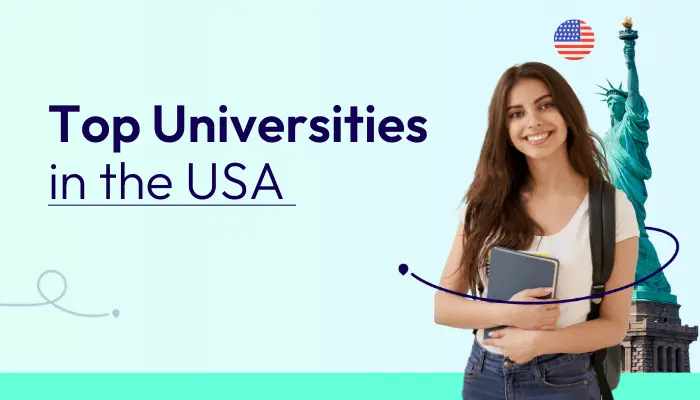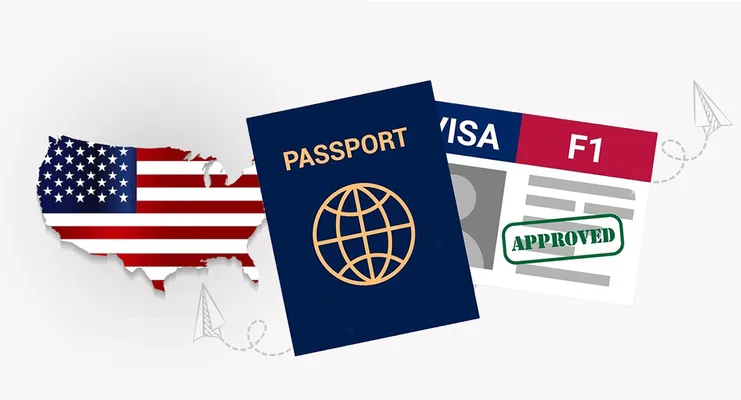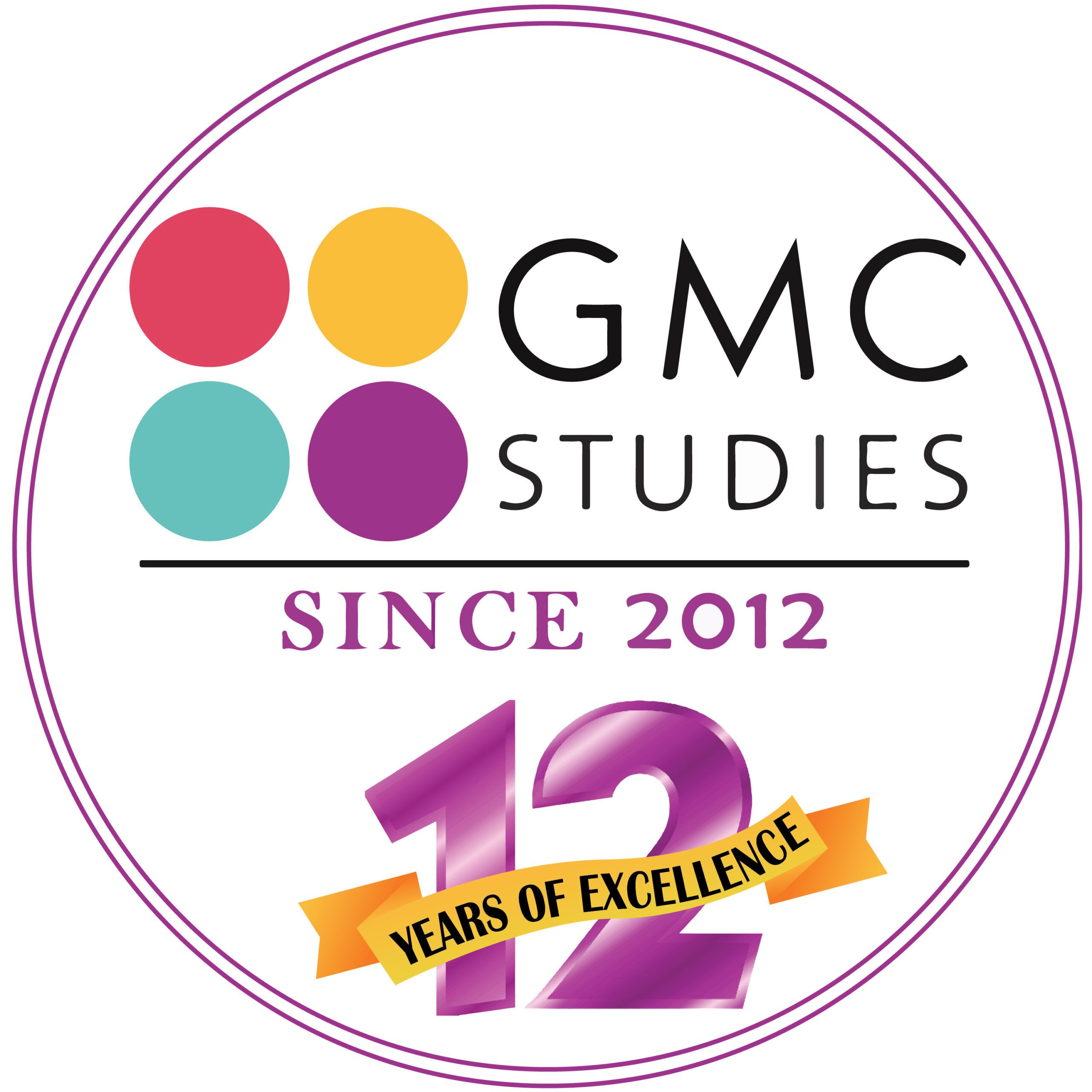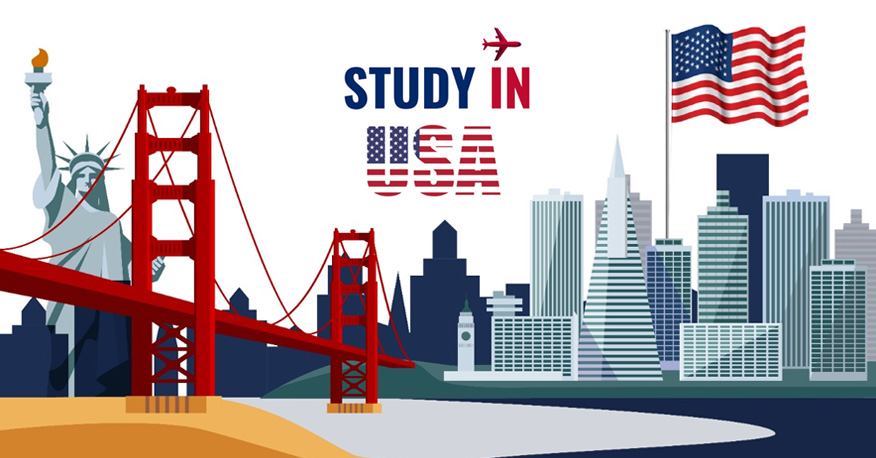Thinking about study in the USA but don’t know where to start? We get it, the whole process can be overwhelming. But don’t stress, we’ve got your back. In this complete guide, we’ll walk you through everything you need to know as an international student looking to study in the States. From picking the right university and program to figuring out how to pay for it all, consider us your new best friend.
We’ll give you the inside scoop on how to navigate the visa process, scholarships you can apply for, and tips from current international students. Whether you’re looking at undergraduate, graduate, or even exchange programs, we’ve got you covered. Get ready to dive into everything you need to make studying in the US a breeze.
Apply Now Study Abroad in The USA
Introduction About Study in The USA

A Wealth of Universities:
The US is home to some of the top universities in the world, including the prestigious Ivy League schools. No matter what you want to study, you’ll find prestigious programs across the country. From technology and engineering at schools like MIT and Caltech to arts and humanities at schools like Yale and Harvard, the options for international students are endless.
Scholarship Opportunities
There are many scholarships offered specifically for international students to study in the USA. Both the universities as well as private organizations offer generous scholarships and financial aid for international students. Some well-known scholarships include the Fulbright Foreign Student Program, the Hubert H. Humphrey Fellowship Program, and the Rotary Foundation Global Grants. With some research, you can find funding to make your US degree affordable.
Experience American Culture

Study in the US is a great way to experience American culture firsthand. You’ll get to see everything from the buzzing energy of New York City to the natural beauty of the Grand Canyon or Yellowstone National Park. No matter which school or city you choose, you’ll get to experience American culture, learn about US history, and make friends from all over the world. An education abroad in the US will provide you cultural experiences and life lessons you’ll never forget.
With world-class universities, generous scholarships, and the opportunity to experience a new culture, studying abroad in the US offers international students the complete education experience. Take advantage of all the US has to offer and open yourself up to new experiences that will change your life. An American education will provide you with a global perspective and connections that will benefit you for years to come.
Top Universities for International Students in the USA

Massachusetts Institute of Technology (MIT)
MIT is one of the top universities in the world, especially for science and engineering. MIT welcomes international students and offers generous financial aid. MIT has over 11,000 students, with international students making up 29% of the undergraduate population.
Stanford University
Stanford University in California is one of the most prestigious universities in the US. It has a strong focus on research and innovation. About 23% of Stanford’s undergraduate students are international. Stanford offers scholarships and financial aid for international students.
Harvard University
Harvard University in Cambridge, Massachusetts is the oldest higher education institution in the US, founded in 1636. Harvard is a large research university with over 20,000 students. International students make up 12% of Harvard’s undergraduate population. Harvard offers need-blind admission for international students and meets the full demonstrated need of all admitted students.
Yale University
Yale University in New Haven, Connecticut is a private Ivy League research university, founded in 1701. Yale has around 12,000 students, with international students comprising 16% of the undergraduate population. Yale practices need-blind admission for international applicants and offers generous financial aid to students with need.
In summary, the top universities for international students in the US are highly ranked, prestigious schools with a strong focus on research and innovation. They offer generous financial aid and scholarships for international students, as well as vibrant campus communities with students from all over the world. Studying at one of these world-renowned universities can open up amazing opportunities. If you get the chance, don’t pass it up!
Popular Degree Programs to Study in the USA
The U.S. is home to some of the top universities in the world, with a variety of programs attracting students from all over the globe. Some of the most popular areas of study for international students include:
Business Administration
A business degree from a prestigious American university is highly valued around the world. Programs like the Master of Business Administration (MBA) teach students leadership, communication, and analytical skills that translate across cultures. With concentrations available in areas like finance, marketing, and entrepreneurship, you can tailor your degree to your interests and career goals.
Engineering
In a world increasingly shaped by technology, engineering degrees are in high demand. Fields like computer science, software engineering, and biomedical engineering are particularly popular for international students in the U.S. You’ll gain hands-on experience and work with cutting-edge technologies that you can take back to your home country. Some of the top engineering schools in America offer generous scholarships and funding for international students.
Computer Science
Closely related to engineering, computer science is one of the fastest-growing and highest-paying areas of study. A degree in computer science, information technology, or software engineering from a U.S. university will prepare you for a career at a major tech company or to launch your own startup. You’ll take courses in programming, data structures, algorithm design, and database management. With tech hubs like Silicon Valley and New York City, the U.S. is the place to be for a computer science education.
In the end, the degree program you choose depends on your interests, talents, and career ambitions. The good news is, as an international student, you have the opportunity to study at some of the top schools in America in nearly any field you can imagine. The possibilities are endless!
Scholarships and Financial Aid for International Students

The cost of a college education in the US can be quite high, especially for international students. Luckily, there are many scholarships, grants, and other financial aid options available to help make your study abroad dreams a reality.
Federal Student Aid
The US government offers loans, grants, and work-study programs for international students. Federal student aid like Pell Grants and direct subsidized loans are only for US citizens, but international students can apply for programs like Federal Work-Study. This program provides part-time jobs for undergraduate and graduate students with financial need.
University Scholarships
Most colleges and universities offer generous scholarship programs for international students to attract top talent from around the world. These are offered based on factors like your GPA, test scores, athletic or artistic talent, field of study, and country of origin. Do some research on the schools you’re interested in to find scholarships you may be eligible for. The deadlines are often in January or February, so start applying early.
Private Scholarships
There are many private organizations, non-profits, and corporations that offer scholarships for international students. These include the MasterCard Foundation Scholars Program, the Paul and Daisy Soros Fellowships, and the Rotary Peace Fellowships. While the eligibility criteria and award amounts vary, they can be very generous. You’ll need to do some digging to find programs you qualify for based on your background, interests, and study goals.
Student Loans
If you need additional funding beyond scholarships, student loans are an option. International students can borrow private student loans and loans through their home country governments. However, international students typically need a co-signer who is a US citizen or permanent resident. Interest rates and terms vary, so compare options carefully.
Paying for your education abroad may seem challenging, but with hard work and persistence, you can find funding to achieve your goals. Do thorough research, apply to as many opportunities as possible, and don’t lose hope! With financial aid, your dream of studying in the USA can become a reality.
Check our another guide for Study Abroad Costs and Benefits 2024
The US Student Visa Application Process

Applying for a US student visa, known as an F-1 visa, involves several steps. First, you must be accepted into a Student and Exchange Visitor Program (SEVP)-certified school, like a university, college or language school. The school will provide you an I-20 form, which shows you meet the admission requirements and have enough funds for your studies.
Submit Visa Application Forms
You will need to submit a visa application form, DS-160, and pay the application fee. Schedule an interview at the nearest US embassy or consulate. You must bring the required documents like a valid passport, the I-20 form, proof of funding for tuition and living expenses, transcripts, test scores, and an admission letter.
Attend Your Visa Interview
The interview aims to determine if you meet the requirements for an F-1 visa. Be prepared to answer questions about your intended course of study, your ties to your home country, and your future plans. Dress in formal business attire and make eye contact. Speak confidently about your study plans. Be ready to show additional documents if requested.
Receive Your Student Visa
If your application is approved, your passport with the F-1 visa will be returned to you. Make sure all the details on the visa are correct before leaving the embassy or consulate. Your F-1 visa will specify the school you may attend, the field of study or degree program, and duration of stay. Once you enter the US, you can stay for the duration of your studies as long as you follow the rules of your student status.
Entry into the US
When you arrive in the US, you will need to go through an inspection with a Customs and Border Protection (CBP) officer at the port of entry, like an airport. Show them your valid passport, F-1 visa and I-20 form. The officer will stamp the date of entry in your passport, granting you F-1 status with a duration of stay up to the end date on your I-20. Welcome to the US! Your exciting educational journey is about to begin.
Tips for Studying in the USA as an International Student
As an international student coming to study in America, the experience can be both exciting and challenging. Here are some tips to help you navigate studying abroad in the US:
Do your research
America has over 4,000 colleges and universities, so do some digging to find schools that offer programs you’re interested in. Check rankings, location, costs, and admission requirements to determine good options for you. The earlier you start researching, the better.
Meet application deadlines
Application deadlines for international students are usually months before domestic student deadlines. Make sure you know when forms and materials are due to avoid missing out.
Apply for scholarships
Studying in the US can be expensive, especially for international students. Apply for scholarships, grants, and financial aid as early as possible. Many schools offer merit-based and need-based scholarships for international applicants. Private organizations also offer scholarships for studying abroad in America.
Improve your English
If English isn’t your first language, focus on improving your reading, writing, speaking, and listening skills. Most schools require English proficiency scores like the TOEFL or IELTS. Take preparatory courses and practice tests to do your best. Strong English skills will also help you thrive living and studying in an English speaking country.
Prepare for culture shock
American culture may be quite different from your own. Prepare for potential culture shock by learning about cultural norms and expectations in America regarding communication, relationships, values, and etiquette. Staying open-minded about cultural differences will help you adjust. Connecting with other international students can also help combat culture shock.
With the right preparation and mindset, studying in America as an international student can be an unforgettable experience. Take advantage of all the opportunities available to you and embrace the challenges. You’ll gain a new perspective on education and life. Best of luck!
Cost of Living in USA
Studying abroad in America can be expensive, so you’ll want to make sure you understand the costs involved before you commit to a program. The cost of living will vary depending on where in the U.S. you choose to study, but here are some estimates to help you budget.
Tuition and fees
For undergraduate international students, average tuition and fees at public universities in the U.S. range from $10,000 to $30,000 per year. Private schools charge $15,000 to $45,000 or more. Graduate program tuition will be higher. Many schools offer scholarships and financial aid for international students, so be sure to apply for any you may be eligible for.
Housing
Housing costs also vary significantly based on location. You can expect to pay between $500 to $1,500 per month to rent a room or small studio apartment. Living on-campus in a dormitory is usually cheaper, ranging from $500 to $1,500 per semester. Living off-campus with roommates in an apartment is often the most affordable option.
Food
For food, budget at least $300 to $500 per month. Eating out at restaurants for most meals will cost $700 per month or more. Buying groceries and cooking some meals yourself will lower your costs. Meal plans at universities range from $1,500 to $5,000 per semester.
Transportation
Most cities in the U.S. have limited public transit, so you may need a car to get around, which requires fuel, insurance, parking and maintenance costs. Otherwise, budget at least $50 to $100 per month for public transit passes. Ride-sharing services charge $15 to $25 per ride.
Health insurance
International students are required to have health insurance in the U.S. Plan on at least $500 to $1,000 per year for a basic policy. Your school may offer an affordable insurance plan for students.
With some budgeting and cost-saving measures, the cost of living and studying in America can be manageable. But go in with realistic expectations for expenses at your chosen school and city to avoid financial stress. The good news is, the investment in your education can pay off with future career opportunities.
Conclusion
If study in the US is your dream, don’t wait—take the first step now. Once you start exploring your options, you’ll find there are many paths to achieving your goal. With hard work and perseverance, you can gain admission to a top university, secure funding, and embark on a life-changing experience.
The US higher education system provides unique benefits. World-class faculty and facilities, flexibility in choosing your courses, opportunities for research and internships, and a vibrant campus culture are just a few of the advantages. While the admission process can seem daunting, many schools and private organizations offer generous scholarships, grants, and other financial aid for international students.
Before you know it, you could be walking through the gates of an Ivy League university or strolling across the quad of a leafy liberal arts college. You might spend a semester gaining valuable work experience at a major tech company or make friends from around the world in your dorm. The possibilities are endless.
Once you’ve obtained your student visa, booked your flight, and packed your bags, a whole new life awaits you. You will have the chance to challenge yourself in new ways, pursue your passions, and chart the course of your future. Years from now, you’ll look back on your time as an international student in America as one of growth, adventure, and opportunity.
The path to following your dreams is often challenging, but the reward is a lifetime of memories that will enrich your life in ways you can’t yet imagine. If studying in the US calls to you, answer that call. Take a chance, spread your wings, and get ready to embark on the learning experience of a lifetime. The sky is the limit, so go ahead—reach for the stars!
FAQ’s
Have you ever considered studying in the USA but had questions holding you back? Here are some of the most frequently asked questions by international students regarding studying in America:
Do I need to know English? While not all universities require proof of English proficiency, it will make your life much easier if you have a good command of English before coming to the U.S. Everything from daily conversations to understanding lectures will require strong English skills. If needed, you can take ESL classes to improve.
How much does it cost? The cost of U.S. universities varies widely depending on the school and program. Public schools charge less for tuition than private schools. Costs include tuition, fees, living expenses, health insurance, etc. Many schools offer scholarships and financial aid for international students. Do your research and plan your budget carefully.
Will I be able to work? International students can work on campus at their university for up to 20 hours a week. After the first year, students in some majors may get Curricular Practical Training (CPT) or Optional Practical Training (OPT) to gain work experience in their field of study. These programs have time limits, so check with your school for details.
Is U.S. higher education recognized worldwide? Yes, degrees from accredited U.S. colleges and universities are widely recognized around the world. U.S. schools are known for a high quality of education, cutting-edge research, diversity, and opportunities to gain valuable experience. A degree from the U.S. can open up many career opportunities.
How do I apply? The application process will vary by school but typically includes submitting an online application, official transcripts, test scores (SAT/ACT, English tests), letters of recommendation, a personal essay, and an application fee. Deadlines are usually between January and March for the fall semester. Apply to multiple schools to increase your chances of getting accepted.
The opportunity to study in the U.S. can be life-changing. Don’t let questions or uncertainty hold you back. Do thorough research, plan well ahead, and follow your dreams of getting a world-class education in America! The experience will open you up to new ways of thinking and pave the path for an exciting future.



